I haven't provided detailed commentary on the US labour market for a while now. To…
Australia labour market – data release not representative of where we are today – Government stimulus underwhelming
The survey week for the – Labour Force, Australia, March 2020 – data, released by the ABS today (April 16, 2020) was before the major policy interventions (lockdown etc). In other words, the data released today is not likely to resemble where the economy was by the end of March or where it is now. Even so, the results are indicative of a slowing economy with weak employment growth failing to outstrip the underlying population growth. As a consequence, unemployment rose by 20,300. Those numbers will be dwarfed in the coming months. The broad labour underutilisation rate (sum of unemployment and underemployment) rose by 0.2 points to 14 per cent. There were a total of 1,924 thousand workers either unemployed or underemployed. This is a deplorable result. My overall assessment is that the Australian labour market remains a considerable distance from full employment and that that distance is increasing. With the coronavirus about to dwarf everything, the prior need for a fiscal stimulus of around 2 per cent has changed to a fiscal stimulus requirement of several times that. There is clear room for some serious fiscal policy expansion at present and the Federal government’s attempts to date have been seriously under-whelming. I estimate the Government will have to inject at least another $A130 billion into the economy (around 40 per cent more than it already has). Not good times ahead.
The summary ABS Labour Force (seasonally adjusted) estimates for March 2020 are:
- Employment increased 5,900 (0.05 per cent) – Full-time employment decreased 400 and part-time employment increased 6,400.
- Unemployment increased 20,300 to 718,600 persons.
- The official unemployment rate increased 0.1 points to 5.2 per cent.
- The participation rate remained steady at 66.0 per cent.
- Aggregate monthly hours worked increased 8.6 million hours (0.48 per cent).
- Underemployment rose by 16.5 thousand or 0.1 points to 8.8 per cent. Overall there are 1,205.3 thousand underemployed workers. The total labour underutilisation rate (unemployment plus underemployment) increased by 0.2 points to 14.0 per cent. There were a total of 1,924.0 thousand workers either unemployed or underemployed.
ABS New Portal for the Coronavirus crisis
The ABS has a new page – Measuring the labour market impacts of COVID-19 – which brings together an array of data sources which will help us assess what is going on more accurately.
With the March data released today, the ABS spokesperson said:
Today’s data shows some small early impact from COVID-19 on the Australian labour market in early March, but any impact from the major COVID-19 related actions will be evident in the April data.
It is also important to note that the Labour Force Survey reference weeks were early in March.
The ABS say:
It is important to note that the reference period for March was 1-14 March, which was before a global pandemic was declared and before the major actions in Australia to contain the spread of the virus.
They also provided this useful graphic time line, which shows the evolution of the policy response to the crisis to date.
This all means that where the labour market is now is not likely to be anywhere near where it was during the survey reference week in the first two weeks of March.
So a sort of relative calm before the storm, although I would not call the situation that Australia was in before the crisis hit as being calm at all.
And because the data is really revealing pre-crisis conditions, the fact that the results show deterioration is indicative that policy was failing even before the medical emergency struck.
And despite what the Government is saying today – the results have nothing at all to do with their fiscal intervention.
Some rough arithmetic
I have been asked a lot during media interviews in the last few weeks whether the current stimulus position of the Australian government, which is a bit over 10 per cent of GDP, is sufficient.
I always answer no, given that all the indications are that unemployment will rise and GDP growth will plummet.
Here is some logic and arithmetic, which I will expand on next week, which bears on the question.
Yesterday, I noted that the Australian Treasury has estimated that the Government’s $A133 billion Job Keeper wage subsidy intervention has in their view reduced the likely unemployment rate of 15 per cent to an expected 10 per cent by June 2020.
The crisis started with the unemployment rate at 5.2 per cent.
The estimates are one thing. But if you think about it, it means the Government has bought 685 thousand jobs for $A133 billion. I will have more to say about this next week.
But it also means, in rough figuring that the intervention was around 5 per cent short of what it had to be to protect jobs.
Meaning: the fiscal stimulus should be at least another $A133 billion or around 6.5 per cent of GDP.
Employment – full-time employment falls and total creeps up in March 2020
1. Employment increased 5,900 (0.2 per cent). This is mediocre.
2. Full-time employment decreased 400 and part-time employment increased 6,400.
The following graph shows the month by month growth in full-time (blue columns), part-time (grey columns) and total employment (green line) for the 24 months to March 2020 using seasonally adjusted data.
The zig-zag pattern where employment growth has regularly been around zero remains evident.
I expect that next month, the green line will plunge into the negative area.
The following table provides an accounting summary of the labour market performance over the last six months.
As the monthly data is highly variable, this Table provides a longer view which allows for a better assessment of the trends.
Assessment:
1. Total employment has fallen behind labour force growth, notwithstanding the decline in participation of 0.1 points.
2. As a consequence unemployment has risen by 9.9 thousand.
Given the variation in the labour force estimates, it is sometimes useful to examine the Employment-to-Population ratio (%) because the underlying population estimates (denominator) are less cyclical and subject to variation than the labour force estimates. This is an alternative measure of the robustness of activity to the unemployment rate, which is sensitive to those labour force swings.
The following graph shows the Employment-to-Population ratio, since March 2008 (the low-point unemployment rate of the last cycle).
It dived with the onset of the GFC, recovered under the boost provided by the fiscal stimulus packages but then went backwards again as the Federal government imposed fiscal austerity in a hare-brained attempt at achieving a fiscal surplus in 2012.
The ratio fell by 0.1 points in March 2020 at 62.5 per cent as a sign that employment growth slowed dramatically and is heading south. The ratio remains below pre-GFC peak in April 2008 of 62.9 per cent.
To put the current monthly performance into perspective, the following graph shows the average monthly employment change for the calendar years from 1980 to 2020 (to date).
1. It is clear that after some lean years, 2017 was a much stronger year if total employment is the indicator.
2. It is also clear that the labour market weakened considerably over 2018 and that situation worsened in 2019.
3. 2020 has not started well and the deterioration will get deeper in the months to come.
The following graph shows the average monthly changes in Full-time and Part-time employment (lower panel) in thousands since 1980.
The interesting result is that during recessions or slow-downs, it is full-time employment that takes the bulk of the adjustment. Even when full-time employment growth is negative, part-time employment usually continues to grow.
The average for full-time employment is not representative given the positive spike in January. That is ‘long ago’ now in terms of the trends ahead and will be deflated in the months to come.
Unemployment increased 0.1 points to 5.2 per cent
The official unemployment rate increased by 0.1 points to 5.231 per cent as employment growth lagged behind the growth in the underlying population with participation steady.
Going into the coronavirus crisis, the Government’s policy settings were biased towards austerity (obsessive pursuit of surplus) and this meant that unemployment had been stuck at elevated levels.
There is now a strong upward bias as a result of the coronavirus crisis.
See my note above about possible unemployment dynamics. It is clear now that the fiscal intervention already announced in two stages by the Government will be insufficient given the scale of the non-government contraction.
If the Treasury estimates that unemployment could easily hit 10 per cent by the end of the financial year (June) are correct, then we know the Government will have failed the nation.
The following graph shows the national unemployment rate from January 1980 to March 2020. The longer time-series helps frame some perspective to what is happening at present.
Assessment:
1. As we enter a new phase of rising unemployment, the rate is still 0.3 points above the level it fell to as a result of the GFC fiscal stimulus (which was withdrawn too early) and 1.3 points above the level reached before the GFC began. So a bad starting point to the next crisis.
2. There is clearly still considerable slack in the labour market that could be absorbed with fiscal stimulus.
3. Its persistently elevated level is directly related to the fiscal austerity that the Federal government has in place. Worse is to come.
Broad labour underutilisation rose by 0.2 points to 14 per cent
The results for March 2020 are (seasonally adjusted):
1. Underemployment rose by 16.5 thousand.
2. The underemployment rate rose by 0.1 points to 8.8 per cent.
2. Overall there are 1,205.3 thousand underemployed workers.
3. The total labour underutilisation rate (unemployment plus underemployment) increased by 0.2 points to 14.0 per cent.
4. There were a total of 1,924.0 thousand workers either unemployed or underemployed.
The following graph plots the seasonally-adjusted underemployment rate in Australia from January 1980 to the March 2020 (blue line) and the broad underutilisation rate over the same period (green line).
The difference between the two lines is the unemployment rate.
The three cyclical peaks correspond to the 1982, 1991 recessions and the more recent downturn.
The other difference between now and the two earlier cycles is that the recovery triggered by the fiscal stimulus in 2008-09 did not persist and as soon as the ‘fiscal surplus’ fetish kicked in in 2012, things went backwards very quickly.
The two earlier peaks were sharp but steadily declined. The last peak fell away on the back of the stimulus but turned again when the stimulus was withdrawn.
In the coming months these graphs will turn sharply upwards.
If hidden unemployment (given the depressed participation rate) is added to the broad ABS figure the best-case (conservative) scenario would see a underutilisation rate well above 15 per cent at present. Please read my blog post – Australian labour underutilisation rate is at least 13.4 per cent – for more discussion on this point.
Teenage labour market apparently bucks trend in March 2020
1. Total teenage net employment rose by 19.2 thousand in March 2020.
2. Full-time teenage employment rose by 7.7 thousand and part-time employment rose by 11.5 thousand.
3. The teenage unemployment rate fell by 1.2 points to 16.7 per cent.
This is an extraordinary result and I suspect there will be revisions next month. It is not clear why the teenage labour market would have experienced one of the best months in years. Aberration is likely.
The following Table shows the distribution of net employment creation in the last month and the last 12 months by full-time/part-time status and age/gender category (15-19 year olds and the rest).
Over the last 12 months, teenagers have gained 9.7 thousand net jobs, while the rest of the labour force gained 227.7 (net) jobs. The overall shift in employment is fairly weak.
In terms of the now completed cycle, which began after the last low-point unemployment rate month (March 2008), the following results are relevant:
1. Since March 2008, there were 2,370 thousand (net) jobs added to the Australian economy but teenagers have lost 54.5 thousand over the same period.
2. Since March 2008, teenagers lost 118.4 thousand full-time jobs (net).
3. Even in the traditionally, concentrated teenage segment – part-time employment, teenagers have gained only 63.8 thousand jobs (net) even though 1128.9 thousand part-time jobs have been added overall.
To put the teenage employment situation in a scale context (relative to their size in the population) the following graph shows the Employment-Population ratios for males, females and total 15-19 year olds since March 2008.
You can interpret this graph as depicting the loss of employment relative to the underlying population of each cohort. We would expect (at least) that this ratio should be constant if not rising somewhat (depending on school participation rates).
The absolute loss of jobs reported above has impacted more on males than females.
The male ratio has fallen by 8.6 percentage points since March 2008, the female ratio has fallen by 4.1 percentage points and the overall teenage employment-population ratio has fallen by 7.4 percentage points.
The other statistic relating to the teenage labour market that is worth highlighting is the decline in the participation rate since the beginning of 2008 when it peaked in March at 61.4 per cent.
In March 2020, the participation rate was just 54.6 per cent. This is a very unreliable statistic overall – it fluctuates widely on a monthly basis.
However, the difference between the 2008 level, amounts to an additional 84 thousand teenagers who have dropped out of the labour force as a result of the weak conditions since the crisis.
If we added them back into the labour force the teenage unemployment rate would be 24.3 per cent rather than the official estimate for March 2020 of 16.7 per cent.
Some may have decided to return to full-time education and abandoned their plans to work. But the data suggests the official unemployment rate is significantly understating the actual situation that teenagers face in the Australian labour market.
Overall, the performance of the teenage labour market leaves a lot to be desired. The decline in full-time employment for teenagers was particularly worrying.
This situation doesn’t rate much priority in the policy debate, which is surprising given that this is our future workforce in an ageing population. Future productivity growth will determine whether the ageing population enjoys a higher standard of living than now or goes backwards.
I continue to recommend that the Australian government immediately announce a major public sector job creation program aimed at employing all the unemployed 15-19 year olds, who are not in full-time education or a credible apprenticeship program.
Hours worked rose by 8.6 million hours (0.48 per cent) in March 2020
This will be the first main indicator of the impacts of the crisis. Firms typically adjust hours worked first to avoid laying off workers they have invested fixed costs in (hiring, training, etc). But that is in a normal downturn.
There is nothing normal about the coronavirus crisis – it has been sudden, and the scale of the lockdown measures widespread.
As such I expect the horus and persons adjustments to be almost simultaneous.
The following graph shows the monthly growth (in per cent) over the last 24 months.
The dark linear line is a simple regression trend of the monthly change – which depicts a decreasing trend. The economy has been underpeforming for nearly 2 years now.
Why? Thinks fiscal surplus obsession. You won’t be far wrong.
Conclusion
My standard monthly warning: we always have to be careful interpreting month to month movements given the way the Labour Force Survey is constructed and implemented.
Given the survey week for the March data release was before the major policy interventions (lockdown etc), the data released today is not likely to resemble where the economy was by the end of March.
The March 2020 data reveals that the Australian economy is in a weak state with a fairly moderate labour market performance being recorded.
Employment growth was weak – 0.05 per cent and failed to outstrip the underlying population growth.
As a consequence, unemployment rose by 20,300. Those numbers will be dwarfed in the coming months.
The broad labour underutilisation rose by 0.2 points to 14 per cent.
There were a total of 1,924 thousand workers either unemployed or underemployed.
This is a deplorable result.
My overall assessment is:
1. The current situation can best be characterised as being in a weak and deteriorating state.
2. The Australian labour market remains a considerable distance from full employment and that that distance is increasing.
3. This persistence in labour wastage indicates that the policy settings are to tight (biased to austerity) and deliberately reducing growth and income generation.
4. With the coronavirus about to dwarf everything, the prior need for a fiscal stimulus of around 2 per cent has changed to a fiscal stimulus requirement of several times that.
5. There is clear room for some serious fiscal policy expansion at present and the Federal government’s attempts to date have been seriously under-whelming.
That is enough for today!
(c) Copyright 2020 William Mitchell. All Rights Reserved.
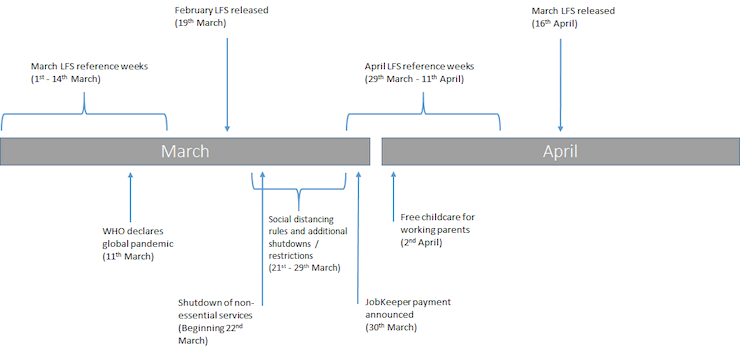
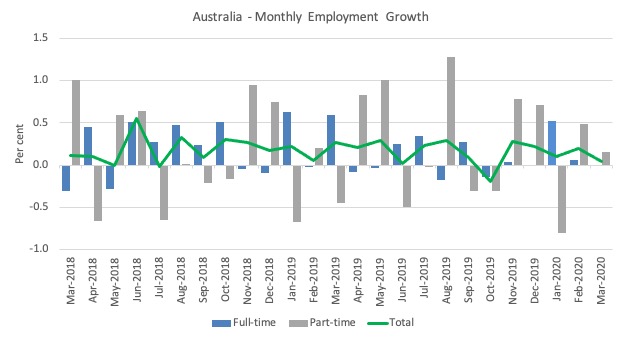
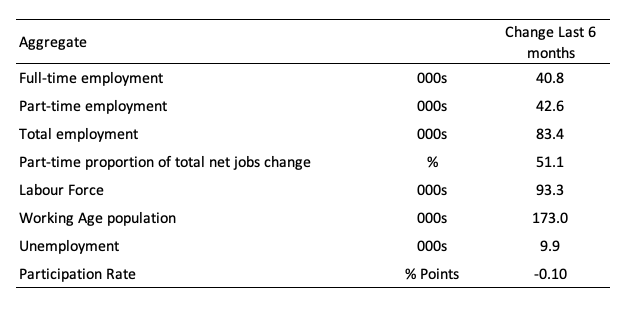
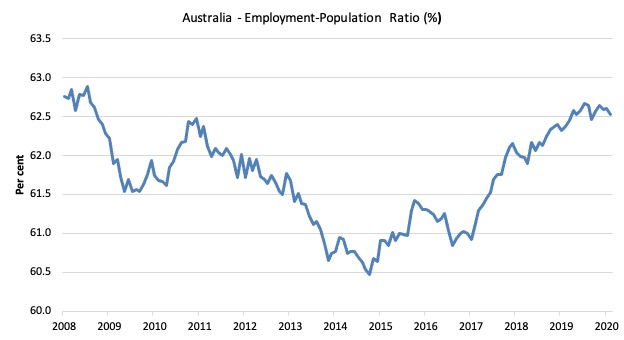
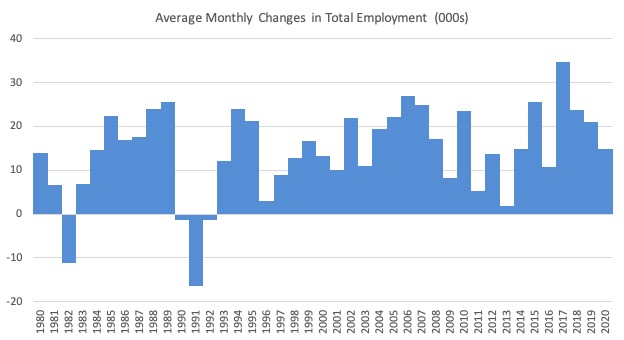
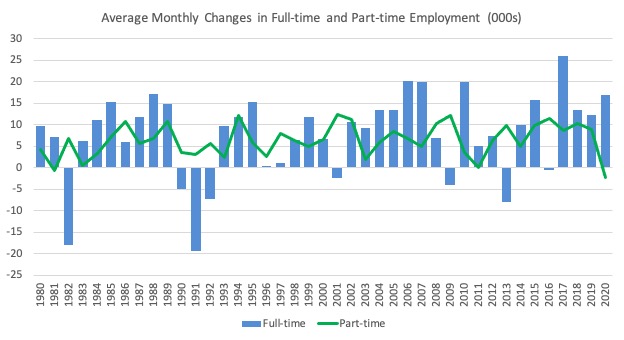
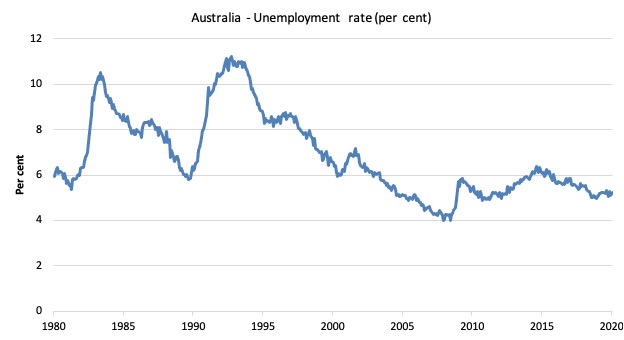
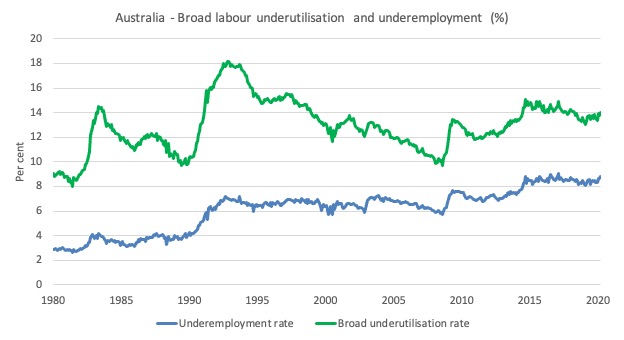
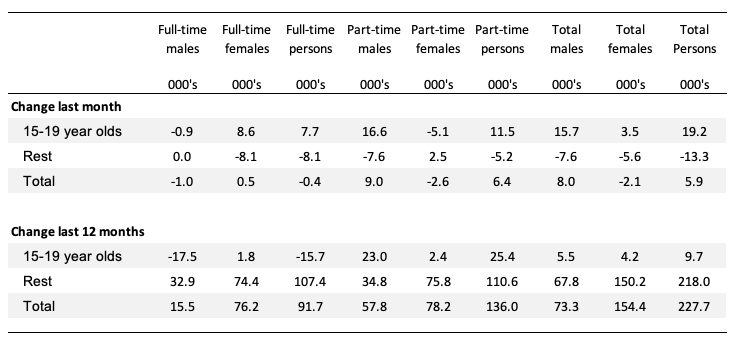
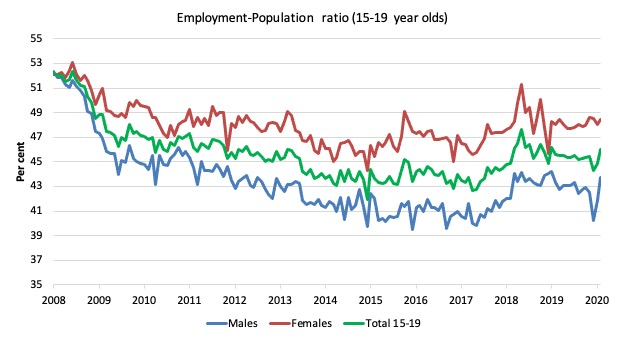
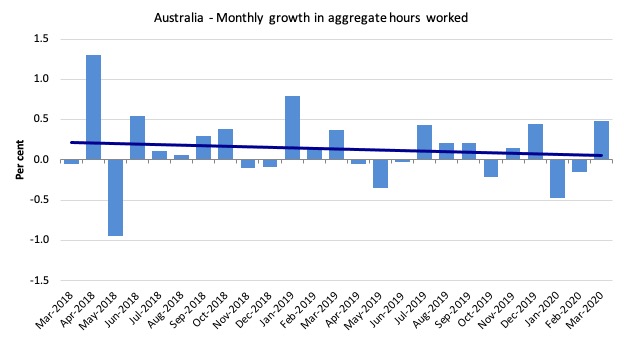
Bill, you wrote, “So a sort of relative calm before the storm, although I would [not] call the situation that Australia was in before the crisis hit as being calm at all.”
Did you leave out the ‘not’?
I have no faith that the ABS is honest with the figures
Bill, you wrote, “1. The current situation can best be characterised as being in a weak and deteriorating state.”
Given your repeatedly saying that these numbers are NOT representative of where the economy is NOW, I think you should not use the word ‘currently” and then also ‘can’ should be changed to ‘could’.
Dear Steve_American, Bill is merely stating the current state of the labour market up until the current data. There is zero confusion in his language.
I wonder if the best way forward at present is to simply explain to the electorate that the currency issuing government can pay for food and accommodation of unemployed workers, without borrowing the money, and without causing inflation, since sufficient food production and accommodation, already exist.
In other words, allow the non-essential workforce to ‘hibernate’ economically, for as long as required.
Then introduce a job guarantee when the economy can be safely reopened.
This pandemic with its *enforced* shut down of the non-essential economy ought to be the time when currency issuance can be understood by the wider public.
When all this stuff started to happen with the corona virus thing, my first worry (aside from dying, or more realistically my father dying) was that supply of essential things was going to disappear. That really hasn’t happened so far, even though the toilet paper crisis has gotten some attention. It helps that it is somewhat humorous for people like me who have odd sense of humor.
What is amazing to me is the drop in demand for most stuff- presumably due to the sudden HUGE increase in people losing their employment here in the US. Maybe you guys in Australia will be behind by a few weeks or more hopefully, have better policy to deal with it than we did. It ain’t no joke which if you didn’t realize from Italy or then Spain or then New York- well you are hopelessly clueless.
Get on your government officials to figure out who has it and who they came in contact with and have those people sequester themselves. Pay them to do that sequestering. Test, test, test. I think someone will come up with some effective treatments soon and hopefully we can develop a vaccine fairly soon. It isn’t going to be ten years in the future for that in this case. I would bet 8 or less months on that. But I’m no medical doctor.
Dr NRL wrote, “Dear Steve_American, Bill is merely stating the current state of the labour market up until the current data. There is zero confusion in his language.”
Maybe but I would have written it as —
1. The situation at the early March reporting date can best be characterised as being in a weak and deteriorating state. And since that time the situation has become pretty dire. Massive deficit spending to help the mass of the people is required and basically cost free.”
Prof. Mitchell is probably right that there will be a need for large fiscal stimulus.
However, this is not a ” the prior need”.
The economy can’t be stimulated if it is in a state of lockdown.
The prior need is to end the lockdown.
[Bill note: edited out video I didn’t wish to promote]
Sorry, OT, but this makes me want to tear my hair out:
“The [UK] chancellor [Rishi Sunak] has congratulated Capt Tom Moore, who has raised more than £13m for the NHS by walking 100 laps of his garden. He paid tribute to his “true Yorkshire grit”.
This is the story of the 99-year old ex-serviceman, who has just walked 100 laps of his garden to “raise money for the NHS” (sic).
Rishi Sunak could have saved the poor bugger the trouble, simply by instructing the BoE to create that additional pittance of £13m, at a keystroke.
We so need to change the narrative that it’s “our” money that pays for public sevices. The money in this case will go to “NHS Charities”. This organisation should not even be necessary in a nation that creates its own currency and has a national health sevice. It just allows people who donate, run marathons, or walk around their gardens 100 times, to have a Cameron-style, Big Society, feelgood moment, whilst at the same time masking the chronic neglect of the NHS at government level.
Charities just serve to sweeten the stench emanating from the sewers of capitalism – but if you critique any of this smug, public-clapping, BBC-circus humbug, you’re painted as a mean, twisted curmudgeon – when, in actual reality, the mean, twisted curmudgeons are the ones who have been at the head of successive Tory governments, who have done the serious damage, that now needs redressing, in the first place! It’s ridiculous.
Capt Tom Moore has now indicated that having been so successful, he plans to keep walking beyond 100 laps, in order to “raise” even more money… or should that be, suck even more money out of people’s pockets, for no rational reason?
“Rishi Sunak could have saved the poor bugger the trouble, simply by instructing the BoE to create that additional pittance of £13m, at a keystroke.”
But he couldn’t have done the £13million of voluntary taxation this also represents.
The charities are essentially private tax collectors – just like the private pension funds. All part of the big push to revert most of public provision to being “alms to the poor” created by wealthy liberal types who like to value signal on a weekend.
And with 750,000 “people of means” doing work for the NHS for nothing they have both sides sewn up
“my first worry (aside from dying or, more realistically my father dying) was that the supply of essential things was going to disappear” Jerry Brown :
We had the huge run on toilet paper here in Canada as well, demonstrating the foolishness of certain people during the outbreak of a respiratory virus. As of yesterday we now also have real concern about the food supply chain as well though.
Liberal free trade policy, has decimated farming here in Canada, to the extent we are overdependent on farming elsewhere (mostly the US). The trend toward agriculture industry monopolies there, makes us all dependent on industrial scale factory farms and processing plants, some of which have been shutdown due to covid-19 outbreaks among a relatively small workforce operating those facilities.
Consequently we are beginning to see empty or poorly stocked food shelves here as well.
There was also a dispute over medical masks, ventilators and other equipment as Donald Trump attempted to ban the export of medical supplies.
The growth of key industries associated with technology development slowed dramatically in Canada during the neo liberal era, as government investment declined.
Now the Trudeau government hopefully (though doubtful) recognizes the folly of spending decades using 19th century liberal thinking arguing in favor of trade policy that makes a nation dependent on foreign sources of just about every item critical for survival in pinch.
Ricardo, Trade agreements, not withstanding; all bets are off when the shtf.
Now we even have the Conservative Andrew Scheer, using this moment to make a pitch for greater “foreign investment” as if government investment isn’t what is needed to support key domestic industries at this point.
@ Neil W,
“But he couldn’t have done the £13million of voluntary taxation this also represents.”
Well he could have done, but tax increases at the moment wouldn’t have gone down very well!
Best, Mr S.
Neil Halliday, yes, this is certainly the time to explain to everyone the nature and operation of fiat money as revealed by MMT, because the phenomena are manifesting right in front of everyone’s eyes. And once people get the concept of fiat money, constrained only by available or readily obtainable resources, the possibilities opened for human agency and societal improvement are staggering and should have massive political consequences. Yet even as trillions are created by keystrokes to protect the plutocrats and expand their power over the rest of us, I continue to cringe when so many on the left continue to drone on and on about “taxpayer dollars.”
@ Mr Shigemitsu
My initial reaction was similar to yours, just a bit more phlegmatic.
Then I began asking myself:- why do people do such objectively stupid and pointless things?
I didn’t come up with the answer. In the case of the gallant captain it could simply be that he has lost more of his marbles than I have (but then he’s a bit older – and I daresay he’ll see me out anyway!).
I surmise that they do it, quite simply, out of the goodness of their hearts. Because they genuinely believe that the NHS *needs* charitable donations and they regard it – quite rightly, given that mistaken premise – as a very deserving cause.
People do feel a compulsion to selflessly contribute to other people’s welfare and – obviously – no one is going to deprecate that admirable impulse. What would be gained – even if it were possible (which it isn’t) – to extinguish it by pouring buckets of cold water over something so spontaneously generous and self-sacrificing, even if it is plain daft? Something noble, I suggest, would have been spurned and nothing but cold rationalism at best and disillusion and cynicism at worst put in its place.
Because *genuine understanding* most assuredly won’t have been – despite all us wise-guys’ efforts at dispelling the prevailing myths.
What harm does it do? (and yes I do know what Neil thinks about that, but I think his perspective is sometimes a bit twisted). There are times when the heart should rule the head IMO, in furtherance of a greater good.
@RobertH,
Thanks for engaging, but I cannot agree, I’m afraid.
“Cold rationalism” is what actually pays for and runs the NHS – and long may that be the case!
The “disillusion and cynicism” is what the Government practices – by dissembling, deceiving, underfunding and propagandising at every turn.
The “harm” is that we are all kept in ignorance of fiscal reality, and that really is not in the interest of the “greater good”.
And I’m actually a big fan of Neil’s perspectival twists!
Best, Mr S.
No- Robert H is correct that people actually do selfless activities in attempts to help others. And it certainly doesn’t harm anyone that they do that. It doesn’t matter that you can argue the government could always do that anyways- it is also very obvious that the government doesn’t always do the right thing. And often times people who are actually making sacrifices in order to help indicate to politicians that maybe some issue is important and they better do something as well.
@ Mr Shigemitsu
I think your sense of humour must have temporarily deserted you. Mine was a plea for a touch of tolerant forebearance instead of unremitting reductionism. Your reply doesn’t address the questions I actually raised, just ignores them.
“”Cold rationalism” is what actually pays for and runs the NHS – and long may that be the case!”
-refutes an argument I didn’t make.
“The “disillusion and cynicism” is what the Government practices – by dissembling, deceiving,
underfunding and propagandising at every turn”
-politicises an argument that wasn’t political.
“The ‘harm’ is that we are all kept in ignorance of fiscal reality, ….”
– is true but isn’t the direct result of people foolishly/quixotically/selflessly (you name it) feeling impelled – as they as non-members of a MMT-informed minority see things – to “help out” (“do your bit” as the wartime phrase had it). That’s just a normal, rather clueless but endearing, piece of human social behaviour. It doesn’t in itself “keep” anybody in ignorance of anything. Making oneself better-informed about fiscal reality is a personal responsibility: an individual citizen can’t blame some other group of people’s charitable behaviour for his/her own failure to take that learning-responsibility upon him/herself.
The volunteers’ actions haven’t stopped you or I from perceiving the truth about the fiscal realities have they – because we take the time to study Bill’s blog – among other sources of knowledge.
“And I’m actually a big fan of Neil’s perspectival twists!”
– One man’s meat….
Now of course the irony of advocating a MMT Job guarantee during lockdown where that job
is to stay at home is, it is only those who are idle that get any of the governments money.
Those of us who have to keep going to work to provide essential stuff [services and goods}
whilst being exposed to the pandemic we do not get any government largesse .
Those who believe that MMT is not MMT without a MMT JG are not living in a MMT world
and probably never will .
“What harm does it do? (and yes I do know what Neil thinks about that, but I think his perspective is sometimes a bit twisted).”
About the same amount of harm as giving beggars on the street money.
Charity isn’t there to help the victims. Charity is there to help the givers feel better about themselves and to avoid actually solving the root cause of the problem – since that would eliminate the need for the charity.
Nobody ever asks why Oxfam still exists, or why Shelter still exists. Because both have failed to solve the problem they were setup to address. They treat the symptoms not the cause.
The best of intentions also suffer from the fallacy of compositions. The job of systems people and economists is to identify fallacies of composition and work out ways by which people can carry on believing the illusion without the problems caused by that illusion. Like the illusion that you can save for a pension.
My twisted perspective is just the ability to see things that are right in front of everybody’s nose. For me the emperor never had any clothes.
“Those of us who have to keep going to work to provide essential stuff [services and goods}
whilst being exposed to the pandemic we do not get any government largesse ”
You do. But you get it on the second pass when the first set of people buy goods and services at the store that you are being paid to supply or provide.
If they didn’t get any of that money, you’d be out of a job completely and we really would be in trouble.
Money doesn’t stop at its first use.
So now ask yourself the real reason why you’re upset that some people are getting money from the government directly, and you’re only getting it indirectly.
It’s not the money that’s the actual issue is it, and even if you got some you’d still be annoyed – particularly when the price of everything went up because you got some.
Work that through and you’ll see why UBI doesn’t work and why people on JG can only be furloughed at home for a short period before they have to go out and do something useful.
“My twisted perspective is just the ability to see things that are right in front of everybody’s nose. For me the emperor never had any clothes”. (Neil Wilson)
I rest my case.
Others will judge for themselves the merits of each.
“Those who believe that MMT is not MMT without a MMT JG are not living in a MMT world
and probably never will .”
What alternative automatic stabilisation process are you proposing then other than the JG that is consistent with MMT – given that MMT specifically rejects the Natural Rate of Interest and Loanable Funds theories upon which Interest Rate Targeting relies.
JG is primarily a replacement for the Interest Rate Jiggling process, and we already know the Unemployment benefit and propping up failing private businesses approach doesn’t work from the experiences of the 60s and 70s. Centrally planned discretionary spending can’t move fast enough – the Communist experience. What else is there?
“I rest my case.”
That case being “I don’t like my beliefs challenged, only confirmed”?
You won’t like it around here then.
We can all empathise with the intent of people’s actions. But the road to hell is paved with good intentions.
And just for the avoidance of doubt I actually agree with the original statement. Many people do indeed act out of a sense of selflessness and duty to help out others.
The question is how do we allow people to do that without negatively impacting others. The harm is there.
For example, volunteers in a system short of work removes paid job opportunities. The solution is enough work, not fewer volunteers.
Similarly donations to public services in a system that wants to defund public services and replace them with mere charities just accelerates that process. The solution to that is not at all clear and may even involve rolling with it and “bailing out” the charities when the contributions dry up in a recession.
@RobertH:
“I think your sense of humour must have temporarily deserted you.”
Never!!!!
I just rang the hospital to see how my Nan is getting on after using one of the new Dyson Ventilators… they said she’s picking up nicely!
Best, Mr S.
Neil Wilson
Friday, April 17, 2020 at 19:47 wrote:-
‘”I rest my case.”
That case being “I don’t like my beliefs challenged, only confirmed”?’
What a transparently bogus non sequitur! And misrepresentation to boot: nothing in what I wrote bears that construction being put upon it. (It’s also ad hominem IMO – not that that troubles me, though I think it ought to trouble you).
To suggest that to allude to the fact that the respective merits of the opposed sides of an argument will be judged by third parties amounts to seeking confirmation of one’s own side totally defies logic.
I’m really surprised you bothered, quite frankly. But (and this was my original point BTW) there’s no limit to the vagaries of human nature – thank goodness! – infuriating though they often are, is there?
@ Mr Shigemitsu
Heartening news indeed!
(both parts of it but especially the second – how old ls is your Nan BTW? I’m 84: perhaps I can draw encouragement from her successful battle with the virus?)
Best
Robert
“I just rang the hospital to see how my Nan is getting on after using one of the new Dyson Ventilators… they said she’s picking up nicely!”
Very good!
@Neil Wilson – I thought taxation destroyed money rather than transferred it. £13m from the pockets of the working classes (predominantly) to charities who spend it is not equivalent to taxation.
Happy to be corrected.
Neil- even you have been charitable in the past. You have used your time to answer many of my questions over the years. It wasn’t like I asked them in order to make you feel good about yourself. Your argument sounds like the crap utility theory that I learned in econ 101. People are capable of genuine altruistic actions to the point of sacrificing their lives in some cases. It is one of the best things about human beings and we should celebrate it rather than discount it.
JonM@22:47- Very good point you make. There is no ‘correction’ to be made to that.
@RobertH,
“how old ls is your Nan BTW?”
Dearest Robert – thank you for your concern, but it was a joke! (You had accused me of losing my sense of humour!)
Both Nans are long gone I’m afraid – one of them I never even met!
Neil I was just teasing those who have always seen welfare payments through the moral lens of
the protestant work ethic coming to the conclusion that when support for the unemployed is
most needed during a global pandemic they suggest paying people to do nothing and calling it a JG programme,while those who keep working see no extra benefit.
I am a healthcare worker in a hospital like all my public sector colleagues helping to keep things
going we get no personal benefit from the second passage of the money which would be spent by
JG recipients if such a scheme existed.I understand Mr Bezos is worth 24 billion more since
pandemic started I think it is the owners of such firms gaining most from the second passage
and first passage of current fiscal stimulus packages around the world.
I do count my blessings in still having my income continue when so many are suffering but if I was
a minimum wage supermarket worker and knew those who had lost their jobs would have a
guaranteed minimum wage job to stay home I might feel i was in the wrong line of work.
There are many millennials who can only dream of the widespread material advances the boomers
achieved in those 60s and 70s that apparently didn’t work.
As to what automatic stabalisers to propose I will leave such wishful thinking to economists.
Good luck with that but for your own piece of mind I would not invest to much hope in such an outcome i have found that brick walls tend to win out over heads in the long run.
solving 80% of a problem doesnt solve anything at all.
building 80% of the bridge to the other side doesnt get you to the other side unless you have to swim for it.
the government really needs to own 100% of the problem
again , conservatives cant get rid of there penny pinching ways completely
I fear the economic assessment of our predicament by the media and politicians is deluded.
Imagine for a moment that you have been working on an important business proposal for several months and your manuscript is almost complete, ready for the submission deadline in a few days time, when suddenly your computer screen freezes and doesn’t respond to any commands.
You reboot the computer several times, but it simply loads the same paralysed screen. In desperation you call the software engineer and when he examines the hard drive, there is bad news.
The program you have used to write the proposal has developed a conflict with the operating system and cannot be recovered. The only solution is to delete the program entirely, which will save all the other files – your music, photographs, emails, contacts and other important personal material – but that means destroying your business proposal and losing out on a profitable opportunity.
If you purchase a brand new PC you lose everything. What do you do?
Our economy is that damaged program. No matter what we try, it will remain frozen and can never be restored. We must simply accept that the data within that program has been fatally corrupted and is unrecoverable – and if we don’t remove it, then we risk losing all the other equally important files too.
Sitting in front of that frozen screen every day won’t put food on the table next week.
It really isn’t a difficult decision.
Kevin Harding- there is no one in the world that doesn’t appreciate health care workers I think. Not at this time. And they deserve a major bump up in pay- especially now.
I used to work for a health care workers union here in the US (in a very, very minor role). Represented mostly nursing home workers and state workers caring for institutionalized people. Unfortunately, it seems like these are the people that are getting hit the hardest in this thing- and the people caring for them are also at very much risk.
I don’t know what else to say than – Thank You!
Not trying to milk it jerry .My field [MRI scanning] is not used to directly manage COVID 19
positive or query patients but some of them still need scanning to manage other conditions
they might also have but very few and with wide spread cancellations my work is actually quieter
right now .My radiographic colleagues in plain film and CT are exposed regularly.
So as i say I count my blessings, still earning, still contributing, still in good health ,got a garden,plenty out there far worse affected by this thing than me.
@ Mark Russell
“It really isn’t a difficult decision”.
As you allegorise it, no it isn’t.
Back in the real world, there’s just one snag:- who makes that “not difficult” decision? viz, to discard the existing (global?) economic-governance regime and then choose with what improved version not in conflict with “the operating system” (= human society, I take you to mean) to replace it.
Deciding who that shall be *IS* a difficult decision. We could perhaps via a medium summon-up from the grave any one of the following (in no particulat order) to make it:-
Marx (Karl not Groucho)
– (on second thoughts, why exclude Groucho…?) –
Lenin
Adam Smith
Keynes or Kalecki
….
Seriously, what *extant* person or body would you propose for the job, on what grounds?
Unfortunately (perhaps – depending on one’s point of view) the human animal is an analogue device.
While Neil is perhaps too blunt, sweeping or grumpy – charity isn’t necessarily all that bad – he (as usual) makes very important, even crucial points reflecting those of great thinkers through the ages.
What he speaks of is the “false/malefic generosity/charity” of Paolo Freire see his Pedagogy of the Oppressed, chapter 1:
“Any attempt to “soften” the power of the oppressor in deference to the weakness of the oppressed almost always manifests itself in the form of false generosity; indeed, the attempt never goes beyond this. In order to have the continued opportunity to express their “generosity,” the oppressors must perpetuate injustice as well. An unjust social order is the permanent fount of this “generosity,” which is nourished by death, despair, and poverty. That is why the dispensers of false generosity become desperate at the slightest threat to its source. True generosity consists precisely in fighting to destroy the causes which nourish false charity.”
Or Tolstoy’s even more famous quote about the rich willing to do anything for the poor – except for getting off their back.
Or most succinctly, the US Great Depression phrase “As cold as charity”.
@ Some Guy
I must admit to never having heard of “great thinker” Paulo Friere (but that probably just reveals deplorable ignorance on my part). If the quote gives any indication though, I don’t think I’ll bother: didactic and dogmatic – a peculiarly unappealing combination.
As for that fraud Tolstoy, George Orwell’s comment on Jonathan Swift applies with equal force to Tolstoy:-
“We are right to think of Swift as a rebel and iconoclast, but except in certain secondary matters, such as his insistence that women should receive the same education as men, he cannot be labelled ‘Left’. He is a Tory anarchist, despising authority while disbelieving in liberty, and preserving the aristocratic outlook while seeing clearly that the existing aristocracy is degenerate and contemptible”.
Personally I’d find it extremely difficult to accept as “great thinking” any opinion about life from such a warped source (I’d exclude his superb literary works – aside from the tedious, self-conscious authorial interruptions into the narrative of “War and Peace” which only detract from its artistic merits).
I think Turgenev was an immeasurably more humane and generous human being and a by no means inferior writer.